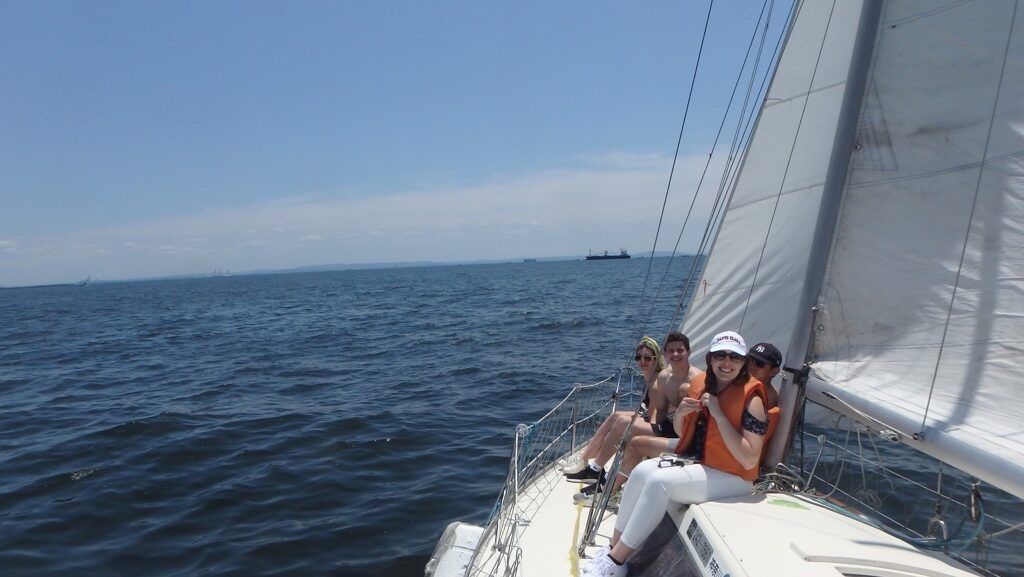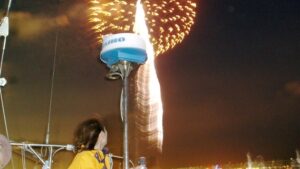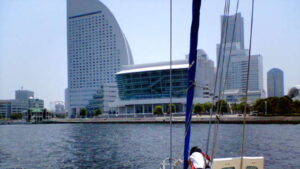by Andy
Blue Mooning in Negishi Bay Yokohama 19th November 2005. Love and sailing have something in common. You never find them, they find you and like religion or love, every sailor will find his or her own unique interesting interest on a sailboat. It was a crisp autumn afternoon on 19th November when she found me at the Negishi Bay in Yokohama. The matchmaker was Captain Taro (CT) a smiling, patient seafarer & IAC-er and his 30 foot sailboat The Bluemoon played cupid.
My fellow sea farers, Kuniko Kazama (IAC member), Mei (Taro’s beautiful cousin), Deva & Christopher (from the US), Jilin (from the Philippines) and I rendezvoused at Captain Taro’s sailing club at noon.
Except for Deva and Christopher, none of us had ever sailed before. Blame it on Hollywood, but frankly, the thought of being helpless at sea at the mercy of the winds and the tempestuous waves was quite disconcerting. It did help to know from CT that a sailboat is designed not to capsize and that if it ever did roll over, it would come back upright again! After an initial round of introductions, we got on board the Bluemoon designed by the Yamaha boat designers and passed it down to CT after use as a prototype. She is one of a kind in the world, and you can recognize her beauty anywhere in Negishi Bay. Pray why, because she is the only one around with a blue body!!!
Seafaring captains are supposedly fierce about their vessels, and messing around with their boats is a strict no-no, I was told. CT was miles away from being Captain Long John Silver (from the book The Treasure Island), quite to the contrary. In true Zen style (Taro is a martial arts instructor), the first thing we were instructed to do was to develop a feel for the boat. “Walk around, get into your elements, find your comfort zones, places convenient to hold and stand,” he cajoled us. As the skipper, I expected CT to throw a rule book at us crammed with sailing terms but surprise again; heartily denouncing the conventional style, CT taught us just enough to know what we were doing! After learning about our starboard, windward, stern, bow, main sails, jib sails, and come-about, we cast off.
With minimal traffic in the bay, it was easy cruising out of the harbour. It is difficult to get the main sail up without at least a couple of experienced hands on board, and since we were novices, CT had to make do with just the jib sail. Bluemoon was fast enough with just the jib sail. The strong and steady wind helped us power ahead, and pretty soon, Bluemoon was heeling to one side at almost a 20-degree angle. This apparently is normal in sailing, chimed CT, as we shifted around the cockpit, trying to balance out the tilt by our collective weight!
Every sailor will find his or her own unique, interesting thing to do on a sailboat, and I found my mind standing at the bow (the foremost part of the boat), hanging onto one of the cables holding the sails in place. As the wind powered the boat ahead, she began to ride the waves, rising and falling along with them. It is a unique experience, almost like riding a roller coaster as one stands on the edge with a fine spray of seawater every time the sailboat dug into one of the waves. Try going sailing with CT once, and he will let you do that! “There is a rule in sailing where the more manoeuvrable ship should give way to the less manoeuvrable craft. I think this is sometimes a good rule to follow in human relationships as well,” said Joyce Brothers, a leading American psychologist. Her point became clear to me as CT explained the two very basic rules for avoiding a collision at sea: 1) Power (engine driven) gives way to sail 2) Port gives way to starboard. This second point means that boats who have their sails set for a breeze coming from the left hand side of the boat (portside) must give way to yachts that have their sails set for a breeze coming from the right side of the boat (starboard side). If both boats have their sails set on the same side of the boat, then the boat closer to where the wind is coming from (the windward boat) must give way to the leeward boat. Efficiently simple enough!
The chief reason why one should go sailing with CT on Bluemoon is that one gets to captain the sailboat for a brief while! CT was kind enough to let us all take turns being the skipper, which meant a chance to control the rudder and, consequently, the direction of the sailboat. While to a bystander, it seems like a relatively easy task to do, the wind speed and the changing direction of wind mean that one has to constantly adjust the rudder to the left and to the right just to stay on course!
After about an hour and a half at sea, we came about and returned to the Negishi harbour. CT is apparently the youngest captain in the harbour and all of us deckhands had to dutifully wave and say “hello” to passing sailboats lest CT gets pulled up for being hostile to fellow captains. CT had a reputation to keep! The sailing had gotten us hungry, and waiting for us was the Beaujolais wine (which had just arrived in Japan for the season), the cheese, and the variety of fare painstakingly prepared by CT’s wife. The fare was set, and thus began a sumptuous wine and cheese party on board the Bluemoon, where she bobbed in unison with the other docked boats. We downed our wine to the sounds of the harbour as the sun began to set over Negishi Bay. With the chill of the breeze coming in with the eve, stars began appearing in the sky, and like the seagulls returning home, we bid adieu to Bluemoon and her smiling Captain Taro.


